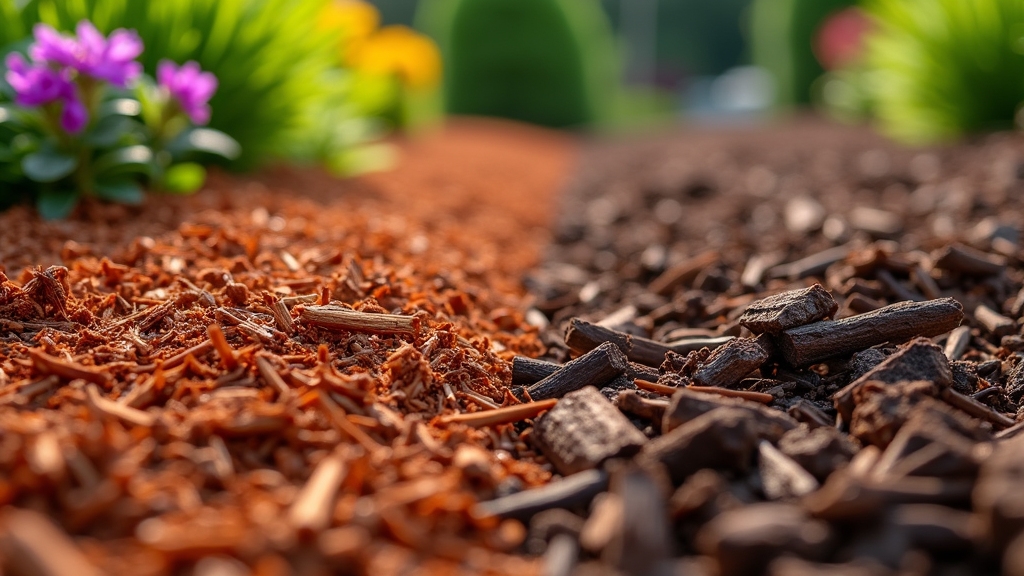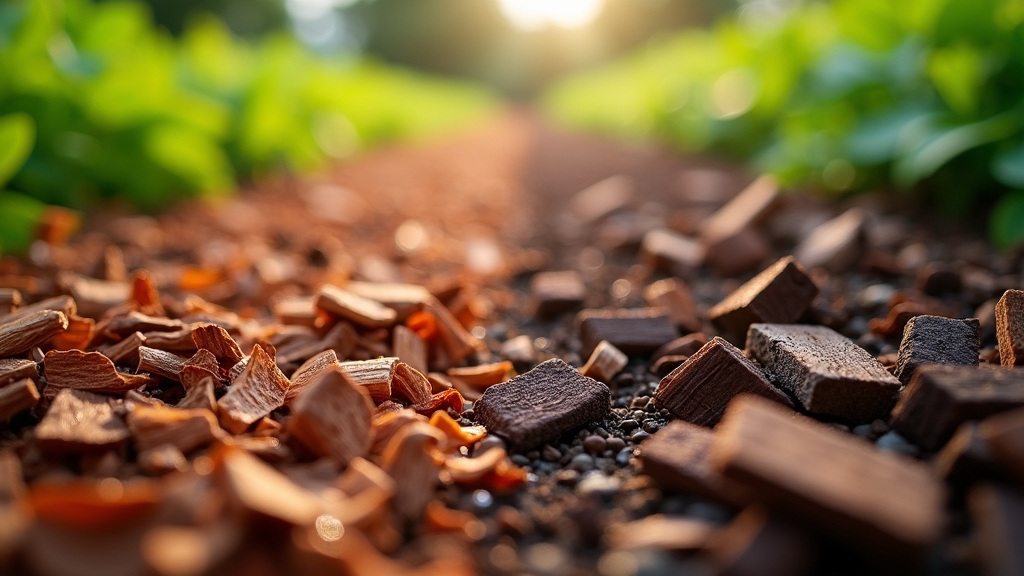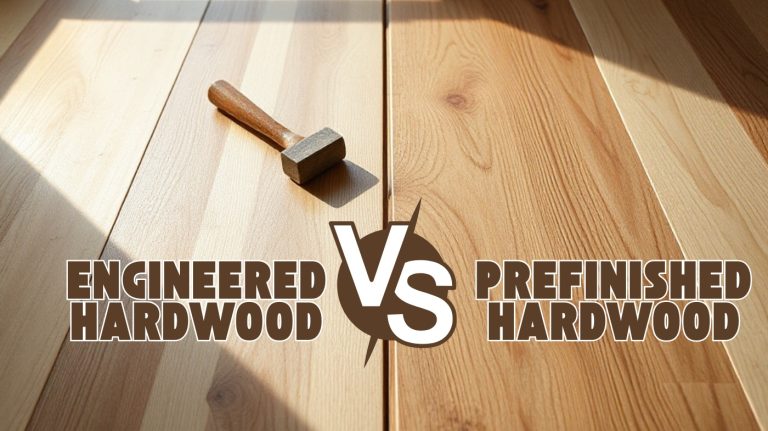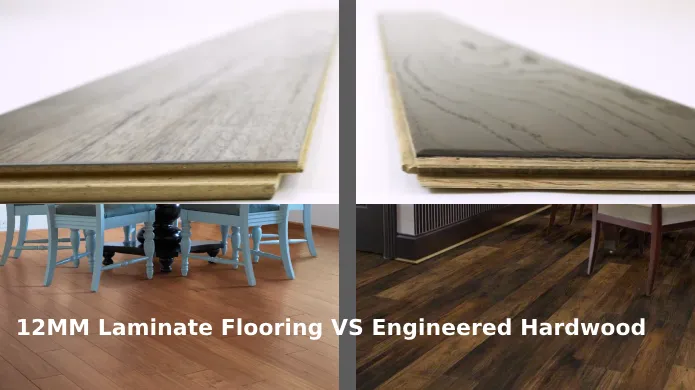Cedar Mulch versus Hardwood: Expert Guide & Tips
When choosing between cedar and hardwood mulch, consider that cedar offers superior pest resistance due to natural oils that repel insects, plus slower decomposition lasting 3-5 years, reducing replacement needs.
Hardwood mulch decomposes faster within 1-2 years, enriching soil with nutrients but requiring more frequent replenishment. Cedar’s aromatic scent and vibrant color fade faster, while hardwood maintains color longer but lacks pest resistance.
Both control weeds effectively with proper application. Exploring further reveals their distinct soil, cost, and maintenance impacts.
- MIGHTY109 100% Natural Shredded Cedar Mulch.
- 100% Natural Forest Product. No Added Chemicals or Dyes
- Great Mulch for Planters, Landscapes, Gardens and more.. 100% Natural Shredded Cedar.
- All-natural mulch: 100% hardwood mulch, no dyes or additives
- Uses: mulch, soil supplement / additive, decor / aesthetics
- Benefits: insulates from temperature extremes, moisture retention, soil nutrients, discourages weeds
Key Takeaways
- Cedar mulch repels pests naturally due to aromatic oils, while hardwood mulch lacks significant pest-resistant properties.
- Hardwood mulch decomposes faster, enriching soil more quickly, whereas cedar mulch lasts longer but provides fewer nutrients.
- Cedar mulch has a vibrant reddish-brown color that fades rapidly; hardwood mulch offers darker, more stable coloration over time.
- Cedar mulch costs more upfront but requires less frequent replacement, making it more cost-effective long-term than hardwood mulch.
- Both mulches suppress weeds effectively when applied 2-4 inches thick, but cedar’s slower decay prolongs its weed control benefits.
Cedar vs Hardwood Mulch: Side-by-Side Analysis
| Feature | Cedar Mulch | Hardwood Mulch |
|---|---|---|
| Lifespan | 3-5 years | 1-2 years |
| Initial Cost | $75-$135 per cubic yard | $30-$70 per cubic yard |
| Pest Resistance | Excellent – Natural oils repel insects | Poor – Attracts decomposers |
| Decomposition Rate | Slow – High lignin content | Fast – Enriches soil quickly |
| Weed Control | Superior – Dense barrier formation | Good – Standard suppression |
| Soil Nutrition | Minimal – Limited nutrient release | High – Rich organic matter |
| Color Retention | Poor – Fades to gray quickly | Excellent – Maintains dark tones |
| Maintenance | Low – Replace every 3-4 years | High – Annual replenishment |
| Best For | Long-term gardens, pest-prone areas | Nutrient-hungry plants, quick enrichment |
| pH Impact | Acidifying – Lowers soil pH | Alkalizing – Raises soil pH |
| Moisture Retention | Excellent – Light color reflects heat | Good – Standard water conservation |
| Environmental Impact | Moderate – Slower tree growth | Better – Uses logging residues |
Soil Health Benefits of Cedar and Hardwood Mulch
Although both cedar and hardwood mulches serve to enhance soil health, cedar mulch offers distinct advantages in weed suppression and moisture retention that directly impact plant growth and soil stability.
Cedar mulch excels in weed control and moisture retention, boosting plant health and soil stability.
You’ll find that cedar forms a dense, 2-3 inch layer blocking sunlight, effectively preventing weed seed germination by reducing seed-to-soil contact. This reduces competition for water, nutrients, and light among your plants. Proper mulch depth is important to maximize these benefits without harming soil oxygen levels.
Additionally, cedar mulch minimizes soil evaporation by shielding soil from sun and wind, helping retain moisture longer. This consistent moisture supports healthier root development and fosters a microenvironment conducive to soil biological activity. Its natural oils also repel pests, reducing the need for chemical insecticides and further protecting plant health.
Cedar’s light color also regulates soil temperature, insulating roots from extremes and promoting steady growth. Maintaining the right moisture balance prevents issues like wood expansion or contraction in nearby plant roots and soil structure.
Comparing Durability and Decomposition Rates
Understanding the soil health benefits of cedar and hardwood mulches sets the stage for examining how their physical longevity and decomposition rates influence their practical use in landscaping.
Cedar mulch, with its high lignin content (30-35%), lasts 2 to 3 years—sometimes up to 5—due to slow decay. This high lignin content is a key factor explaining cedar’s longer mulch lifespan. Its resistance to decay also means it requires less frequent replacement, reducing maintenance efforts over time.
Hardwood mulch decomposes faster, lasting 1 to 2 years and losing 1-2 inches of thickness in the first year. Key distinctions include:
- Cedar’s slow decomposition maintains mulch volume and coverage longer.
- Hardwood mulch decomposes moderately, releasing nutrients faster.
- Climate impacts both; hot, humid conditions accelerate decay.
- Cedar’s durability means less frequent replacement, benefiting long-term maintenance.
You’ll want to weigh these factors carefully when selecting mulch for your landscape’s longevity and nutrient management needs.
Pest Resistance Characteristics of Both Mulches
When selecting mulch for your landscape, you’ll want to take into account how its natural properties influence pest resistance. Cedar mulch contains natural oils like thujone that repel termites, moths, ants, and mosquitoes. It emits an aromatic scent that strengthens with moisture, enhancing deterrence.
Additionally, installing cedar chips in landscape beds can minimize pest invasion outdoors, providing a more pest-free area. Regular maintenance is necessary to preserve these properties and prevent mulch decomposition that could attract pests or harm the underlying soil.
These insecticidal compounds reduce attractiveness to wood-boring insects without synthetic chemicals, making cedar mulch ideal for organic gardening.
Natural insecticidal properties deter wood-boring insects, making cedar mulch perfect for organic gardens.
Conversely, hardwood mulch lacks these oils, making it more susceptible to termites and a broader range of insects, including decomposers attracted by fungal decay. Vacuuming or sweeping the surrounding area can help reduce debris accumulation that might exacerbate pest issues.
Cedar’s termite-resistant heartwood offers superior protection compared to hardwood, though both contain sapwood vulnerable to termites. However, cedar’s repellency can also reduce beneficial insects, potentially impacting soil health.
You should maintain cedar mulch properly and combine it with integrated pest management to optimize pest resistance and ecosystem balance. Using gentle cleaning methods around mulch beds can prevent damage to the mulch and surrounding plants while controlling pest-attracting debris.
Weed Control Efficiency in Cedar and Hardwood Mulch
Since effective weed control hinges on blocking sunlight and managing soil conditions, both cedar and hardwood mulches play essential roles by forming physical barriers that inhibit weed seed germination.
You’ll find cedar mulch naturally suppresses weeds through light blockage and moisture retention but requires careful thickness to avoid water repellency. Its natural insect repellent qualities also contribute to reducing pest-related plant stress. Proper application techniques can significantly improve mulch performance and longevity.
Hardwood mulch also blocks light and retains moisture, decomposing faster yet providing nutrient benefits that support soil health. Regular maintenance and careful inspection help sustain mulch effectiveness over time.
To optimize weed control, focus on applying 2-4 inches of mulch evenly to prevent seed-to-soil contact and removing existing weeds before mulching to eliminate initial growth.
Consider cedar’s longer-lasting suppression due to slower decomposition and manage moisture carefully with cedar to maintain effective weed inhibition.
Aesthetic Appeal and Color Retention Differences

Beyond weed control, the visual characteristics of mulch considerably influence landscape design choices. Cedar mulch offers a vibrant reddish-brown hue and coarse texture that immediately enhances garden aesthetics and adds a distinctive woodsy aroma. Additionally, cedar mulch is naturally pest-resistant, which can help reduce insect problems in the garden.
However, its color fades rapidly—often within months—due to sun exposure, rain, and compaction, shifting to dull gray tones. Hardwood mulch, by contrast, presents darker brown to nearly black shades that remain stable longer because of dense composting and aging.
Its finer texture maintains an even, consistent appearance despite weathering. Proper maintenance routines can help prolong the aesthetic appeal of mulch in landscape settings. While cedar’s slower decomposition preserves structure and texture, it demands more frequent replacement to sustain visual vibrancy.
Hardwood mulch’s color stability and subtle tones provide a low-maintenance, classic backdrop that complements diverse landscapes. This makes your choice dependent on desired warmth versus longevity in color retention.
Application Techniques and Coverage Efficiency
Although both cedar and hardwood mulches require an ideal layer depth of 2 to 4 inches for effective weed suppression and moisture retention, you must adjust application techniques based on mulch type and plant needs.
Cedar mulch typically needs 2 to 3 inches to balance pest deterrence with airflow. It contains natural oils that deter insects like termites and ants, adding a protective benefit beyond just coverage. pest-repelling properties
Hardwood mulch can be applied up to 4 inches, especially in nutrient-demanding beds. Applying mulch evenly without excessive thickness helps prevent issues like moisture buildup and promotes healthy soil.
Avoid piling mulch against stems to prevent rot. Proper site preparation, including weed clearing and soil leveling, ensures even coverage and mulch stability. Preparing the soil by removing debris and leveling the surface facilitates better mulch adhesion and longevity.
To optimize application and coverage efficiency, you should maintain a mulch-free zone of a few inches around plant stems. Aerate and amend soil before mulching. Apply mulch evenly without excessive thickness. Replenish mulch regularly, noting hardwood decomposes faster than cedar. decomposes over 1-2 years
Initial Price Differences
When comparing initial costs, you’ll find that cedar mulch commands a premium price, typically ranging from $75 to over $100 per cubic yard. In contrast, hardwood mulch is generally priced between $30 and $65 per cubic yard. This price gap primarily reflects cedar’s unique properties such as aroma and insect resistance.
Additionally, understanding the cost factors involved helps in making a well-informed choice. Bulk purchases lower per-yard costs but maintain this relative difference. One cubic yard of mulch covers approximately 108 sq ft at a 3-inch depth, helping to estimate how much mulch is needed for your project.
Bagged cedar mulch also carries a higher cost per 2 cubic foot bag compared to hardwood. Installation labor adds $20 to $55 per cubic yard regardless of mulch type. Labor costs can vary depending on project complexity and location. However, total expenses rise with cedar due to material price.
Key factors to consider include:
- Cedar’s premium price justified by functional benefits
- Hardwood’s budget-friendly upfront cost
- Bulk versus bagged pricing variations
- Labor and delivery fees independent of mulch type
Replacement Frequency Impact
Beyond the upfront cost differences between cedar and hardwood mulch, replacement frequency considerably influences long-term expenses and value.
Cedar mulch lasts 2 to 4 years due to high lignin content, reducing the need for frequent replacement. This cuts labor and material costs over time. Moreover, as cedar mulch is made from lumber industry byproducts, it helps minimize waste in the production process.
Applying a fire retardant product can also enhance cedar mulch’s durability and safety in fire-prone areas. Hardwood mulch decomposes faster, requiring replacement every 1 to 2 years. This increases ongoing expenses and soil exposure during changeovers.
While cedar’s longevity limits soil disruption and operational costs, hardwood’s rapid breakdown enhances soil nutrients but demands more frequent applications and top-offs. You should also consider climate: warm, humid conditions accelerate decomposition, especially for hardwood.
Though cedar’s color fading may prompt earlier replacement, its extended durability generally provides better cost efficiency and maintenance ease, making it advantageous for long-term landscaping investments despite a higher initial price.
Environmental Impact and Sustainability Considerations
When choosing between cedar and hardwood mulch, you need to assess resource renewability carefully. Cedar often comes from mature trees with slower replenishment rates, which can impact sustainability. Pine mulch, by contrast, is considered more renewable due to the faster growth and replenishment of pine trees.
You’ll also want to think about how each mulch decomposes and affects soil chemistry. Cedar’s slow breakdown offers limited nutrient release but influences soil acidity. Additionally, evaluating the presence or absence of chemical treatments is essential.
These treatments can impact both environmental safety and plant health. Considering proper maintenance and care of mulch layers helps ensure that your mulch choice supports long-term environmental health and garden vitality.
Resource Renewability Comparison
Although both cedar and hardwood mulches offer renewable raw materials, their sustainability profiles differ markedly due to growth rates, sourcing practices, and geographic constraints.
You’ll find cedar mulch derived primarily from specific cedar species, which take longer to mature and are regionally concentrated, affecting renewability. Hardwood mulch sources vary widely, often using logging residues and urban trimmings, enhancing resource efficiency.
Sustainable forestry management is critical for both to prevent ecosystem degradation. Additionally, hardwood bark mulch provides benefits such as water conservation and soil protection against evaporation, promoting healthier soil ecosystems.
Key points to contemplate:
- Cedar trees grow relatively fast but have a limited geographic range.
- Hardwood mulches utilize mixed species and often repurpose forestry byproducts.
- Cedar mulch production can be resource-intensive due to slower growth and transport.
- Hardwood mulch generally benefits from local sourcing, reducing environmental footprint.
Decomposition and Soil Benefits
Since decomposition rate directly influences soil benefits and mulch longevity, understanding how cedar and hardwood mulches break down is essential for sustainable landscaping.
Cedar mulch decomposes slowly, lasting 3 to 5 years due to its decay-resistant red cedar wood and bark. This slow breakdown provides prolonged soil cover but results in minimal nutrient input.
Conversely, hardwood mulch decomposes within 1 to 2 years, enriching soil organic matter and enhancing fertility more rapidly. Hardwood’s faster breakdown improves moisture retention and microbial activity but risks compaction, potentially impeding aeration.
Cedar’s fibrous texture reduces compaction but may form dense layers if overly applied. Both mulches cause temporary nitrogen depletion during decomposition, requiring nutrient management.
Additionally, cedar’s natural pest repellents indirectly benefit soil biota, while hardwood supports greater microbial diversity. Balancing mulch choice with these factors optimizes soil health and sustainability.
Chemical Treatments Impact
Understanding how mulch decomposes is only part of the picture; the chemical treatments applied to cedar mulch considerably influence its environmental impact and sustainability profile.
Dyed cedar mulch often contains heavy metals like chromium and arsenic, which leach into soil, harming beneficial microorganisms and pollinators. You should avoid mulches with recycled construction debris or CCA-treated wood, as these introduce persistent toxins.
Certified virgin wood mulches eliminate these risks by excluding chemically treated materials. Consider that chemical leaching disrupts soil nutrient cycles and reduces microbial biodiversity.
Untreated, naturally colored cedar mulch supports healthier soil ecosystems. Persistent chemical residues contaminate groundwater and harm beneficial insects.
Sustainable mulches rely on clear certification to verify chemical-free sourcing. Choosing untreated, certified cedar mulch enhances soil health and reduces environmental contamination risks.
Additionally, cedar mulch’s slow decomposition rate means it contributes minimal nutrients back to the soil, unlike other organic mulches that enrich soil fertility over time.
Ideal Landscaping Uses for Cedar and Hardwood Mulch
When selecting mulch for your landscaping, consider how cedar and hardwood varieties perform under different conditions and design goals.
Choose cedar mulch for areas requiring long-lasting weed suppression, moisture retention, and temperature regulation, such as vegetable gardens and ornamental beds. Its natural oils repel pests, reducing chemical interventions, and its shredded texture resists displacement by wind or rain.
Additionally, cedar mulch contains thujaplicin, a chemical that helps prevent fungal and bacterial growth, promoting healthier soil conditions.
Opt for cedar mulch to enhance weed control, retain moisture, regulate temperature, and naturally repel pests in your garden.
Cedar’s light color and slow decomposition provide sustained soil cooling and aesthetic appeal for visible garden pathways.
Hardwood mulch suits landscapes where rapid decomposition enriches soil nutrients and where pest repellent properties are less critical. Its darker hues complement shaded areas or informal beds.
Both mulches reduce weed competition and conserve moisture, but your choice depends on balancing durability, pest management, and visual preferences tailored to specific landscape functions and environmental challenges.
Maintenance Requirements and Best Practices
Although cedar and hardwood mulches serve similar purposes, their maintenance demands differ markedly due to variations in decomposition rates, pest resistance, and nutrient release. Cedar mulch decomposes slowly, requiring replenishment every two years, while hardwood mulch breaks down faster, needing more frequent topping up.
Cedar’s natural oils repel pests, reducing insect damage, whereas hardwood mulch demands closer monitoring. Both suppress weeds effectively but still require occasional weeding and patch replacement. Laying landscape fabric can be used beneath mulch to enhance weed suppression.
To optimize maintenance, you should maintain a 2-4 inch mulch depth, avoiding contact with stems to prevent rot. Evenly distribute mulch and water lightly after application.
Replace or refresh mulch layers when color fades or decomposition advances. Monitor pest activity, especially with hardwood mulch, and remove decayed patches promptly.
Frequently Asked Questions
Can Cedar or Hardwood Mulch Be Used for Vegetable Gardens Safely?
You can use hardwood mulch safely in vegetable gardens because it breaks down faster and supports soil fertility without severely depleting nitrogen.
Cedar mulch, though pest-repellent, risks nitrogen immobilization and slower nutrient return, making it less ideal for annual vegetables. If you choose cedar, apply it only as a surface layer and avoid mixing it into the soil.
Always monitor soil nutrients and supplement nitrogen to maintain healthy vegetable growth.
Do Either Mulches Attract Specific Wildlife or Beneficial Insects?
You’ll find hardwood mulch attracts more beneficial insects like pollinators and decomposers because it lacks natural repellents and breaks down faster, creating microhabitats.
Cedar mulch, rich in natural oils like thujone, repels many pests and beneficial insects alike, limiting their presence. While termites may target sapwood in both, cedar heartwood resists them better.
How Do Cedar and Hardwood Mulch Affect Soil pH Levels?
Imagine your azaleas struggling after mulching. Cedar mulch lowers soil pH gradually, acidifying the soil due to its slow decomposition and natural oils. This benefits acid-loving plants but harms neutral or alkaline-preferring species.
Hardwood mulch, decomposing faster, raises soil pH, increasing alkalinity, which might inhibit acidophilic plants like rhododendrons. You’ll want to monitor pH regularly, adjusting mulch type and application frequency to maintain best soil chemistry for your specific plants.
Are There Any Allergy Concerns Related to Cedar or Hardwood Mulch?
Yes, you should be aware that cedar mulch contains cedar oil and pollen, potent allergens that can trigger respiratory issues, skin irritation, and worsen asthma symptoms.
Hardwood mulch generally poses fewer allergy risks but may harbor mold spores, which can also provoke allergic rhinitis or asthma. If you or your pets are sensitive, avoid cedar near entrances and consider allergy testing.
Can These Mulches Be Mixed Without Issues?
You can mix cedar and hardwood mulches, but it’s not ideal. Since cedar decomposes slowly—lasting 3 to 5 years—and hardwood breaks down faster, mixing them causes uneven mulch longevity and maintenance challenges.
Additionally, combining their differing effects on soil pH and pest resistance may disrupt nutrient availability and reduce cedar’s natural insect-repelling benefits.
Time to Upgrade Your Landscape: Cedar or Hardwood Awaits
When choosing between cedar and hardwood mulch, consider that cedar lasts up to three times longer than hardwood, reducing replacement frequency and long-term costs. Cedar’s natural pest resistance and slower decomposition enhance soil health and weed control.
Hardwood offers richer nutrient release. Balancing durability, environmental impact, and maintenance needs will help you optimize your landscape. Understanding these technical differences guarantees you select the mulch that best supports your specific gardening goals and conditions.
- 100% Cedar Bark and Cedar Wood Fiber.
- Natural source of nitrogen that promotes healthy plants and root growth.
- Natural aromatic smell makes it pleasant to work with and be around.
- 100% Natural and Organic: Sourced directly from the USA’s heartland, ensuring an eco-friendly and…
- Nutrient-Rich Composition: Enriches soil with essential nutrients, promoting healthier, more…
- Superior Moisture Retention: Keeps your garden hydrated by conserving water and reducing the need…
Last update on 2025-12-31 / Affiliate links / Images from Amazon Product Advertising API











